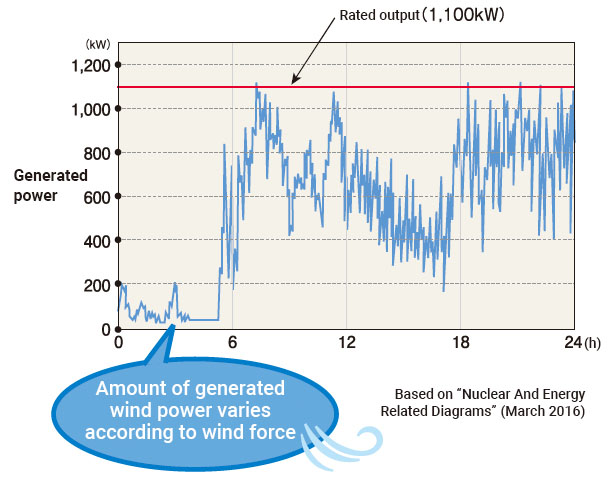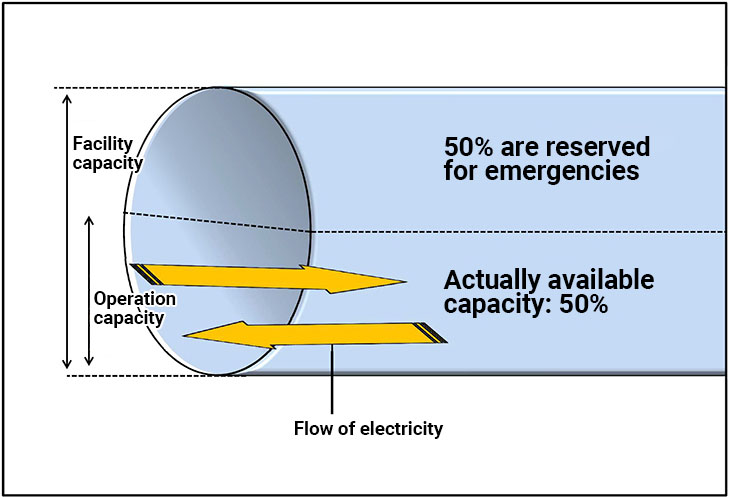Promotion of Renewable Energy Sources
Renewable energy refers to energy that is always present in the natural world, including energy derived from resources such as sunlight, wind, and geothermal energy. It is increasingly attracting attention as an environmentally friendly form of energy without the fear of depletion.
The Kansai Electric Power Group is proactively promoting renewable energy in order to secure a stable electricity supply in the future and realize a low-carbon society.
On the other hand, because renewable energy is usually subject to the influence of weather conditions, careful fine-tuning is necessary in order to keep the power system frequency constant.
Furthermore, we are working towards reducing and eliminating limitations when connecting renewable energy sources to the existing grid. To this end, we are reviewing operation methods and strengthening the transmission line network along with other initiatives.
Features of Renewable Energy
Advantages of renewable energy
- No fear of depletion
- Domestically sourced without need to import
- No CO2 emissions during power generation
Problems of renewable energy
- Low energy density (a measure of how much power can be generated per area unit) means that large area and large facilities are required.
- Solar power generation, wind power generation or the like are dependent on weather and nature conditions and therefore not stable.
Example of solar power generation output fluctuation (Spring)

Example of wind power generation output fluctuation (Winter)

Initiatives as a Power Transmission and Distribution Company
If the balance between demand (electric power usage) and supply (power generation volume) is lost, the power frequency will be affected. In a worst-case scenario, large-scale power outages can occur.

Because the output volume of solar power and wind power generation fluctuates dramatically due to the weather and other environmental factors, there may be situations where there is too much power or not enough power.
Kansai Transmission and Distribution therefore relies on power generation sources that can be adjusted, such as thermal power generation and hydropower generation. By adjusting the output volume of these sources as needed, the overall supply/demand balance can be maintained.
With a view towards the increased use of renewable energy sources, we are expanding wide-area adjustment capabilities, and we are reviewing transmission line operation methods and expanding the network to accommodate connection applications for renewable energy sources.
(1) Relieving constraints on supply/demand balance
In a season with low demand, increase of generated power from renewable energy sources may result in a surplus, that is, too much electricity than required.
In such a case, we will perform adjustment by reducing thermal power generation or the like in a certain area, for example the Kansai area, and then perform adjustment in other areas as needed.
If there is still a surplus, we will use regional interconnectors to send electricity to other areas.
Finally, if further measures are needed, the output volume of solar power generation and wind power generation will be limited.
(2) Measures against constraints on power transmission capacity
Strengthening transmission line capacity
As the number of renewable energy operators keeps increasing, the number of connection applications to the electrical power system (the overall system and framework of power generation and power transmission and distribution facilities) has increased accordingly, leading to a shortage in transmission and distribution capacity.
Therefore, we are increasing transmission capacity by creating new power transmission facilities as appropriate.
Japanese version of Connect & Manage
Japan's electric power facilities system is designed to prevent power outages by passing power to another transmission line if one transmission line fails.
For example, if one of two transmission lines fails, the load will be switched to the other line. To prevent overloading the second line in such a case, the load of each line at normal operation is set not to exceed 50%*, leaving the remaining 50% for emergency use.
* Simplified example with two lines only

Source: Website of Agency for Natural Resources and Energy (https://www.enecho.meti.go.jp/about/special/johoteikyo/akiyouryou.html)
“Connect & Manage” is a system that utilizes some of the capacity reserved for emergency use, as well as “gap” time slots when not much power generation occurs, in order to enable the handling of a higher volume of electricity. It has already been introduced for example in the United Kingdom and Ireland.
Building new power transmission facilities to secure additional transmission capacity requires a lot of time and capital. A Japanese version of “Connect & Manage” should be able to maximize utilization of existing facilities in order to solve the above-mentioned issues.
Flick for details.

Source: Website of Agency for Natural Resources and Energy (https://www.enecho.meti.go.jp/about/special/johoteikyo/akiyouryou.html)
- (1) Calculation is based on real-life usage ratios rather than assuming that all power sources are operating at full capacity.
- (2) A part of the capacity that had been reserved for emergency use is to be utilized in regular conditions, but with measures such as the capability for immediate cutoff in case of an incident.
- (3) New connections are made possible, with the provision that control will be implemented when the system is busy such as while other power sources are operating.
Corporate Information Menu

